Do-it-yourself boiler repair: possible malfunctions and instructions for eliminating them
An electric water heater, like everything on earth, does not last forever.Poor quality of the device itself, improper operation, installation errors and unfortunate accidents can damage the device. In case of minor breakdowns, it is not difficult to repair the boiler yourself, but a number of faults can only be corrected in a service center.
We will tell you what problems in the operation of water heating equipment can be eliminated yourself. The article we presented presents the nuances of diagnostics and describes in detail how to restore the operation of the unit. Helpful recommendations for maintenance are given.
The content of the article:
How does a boiler work?
There are storage and instantaneous water heaters. The first ones consist of a large container in which a heating element is installed. Water enters the device and is stored there at a certain temperature.
By using temperature sensorconnected to the thermostat, the temperature is maintained at the set level. To prevent loss of thermal energy, the body of the storage tank is covered with a layer of insulation.
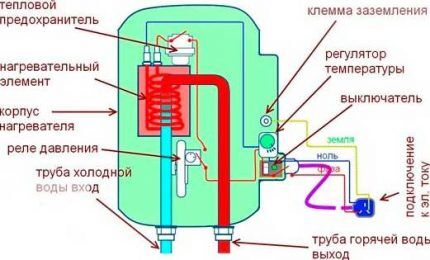
Flow models work differently. They also have a housing and a heating element, but do not store water inside. The device turns on the moment water flows through its body.
The liquid quickly heats up to the desired temperature.These devices are more powerful than storage models; they consume more electricity. But their sizes are compact and installation is a little easier.
And yet, in everyday life, a storage version of the water heater is more often used. Failures of different types of devices are similar, and they are eliminated using approximately the same means.
To automate the operation of the water heater, use a thermostat. This element receives its current state using temperature sensor. It turns the heating element on and off based on incoming information.
This helps not only maintain the optimal temperature inside the drive, but also makes it possible to save energy. The device also prevents dangerous overheating of water, which could cause a serious accident.
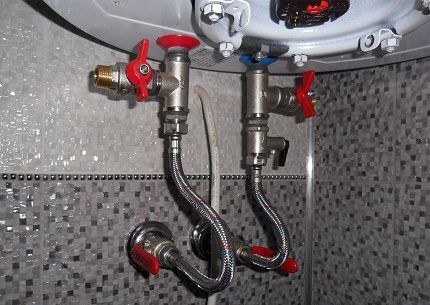
Hot water is gradually withdrawn from the tank and replaced by cold streams from the water supply. At this moment the heating element usually turns on. If the hot water in the boiler has not been used for a long time, it may cool down. Too low a temperature also gives a signal to turn on heating element.
With features of choice electric water heaters will introduce you to an article devoted to the design differences and technical characteristics of equipment models popular among consumers.
Types of heaters according to the heating element used
There are boilers with “dry” and “wet” heating element. In the first version, the heating element is placed in a special flask, and in the second it is in direct contact with water. Both models have certain advantages.
In terms of boiler repair, it is considered “dry” heating element replacing is much easier than a “wet” one, since to do this you just need to remove it from the flask and put a new element there.
In the case of “wet” heating element You will first have to completely drain the water from the container, and only then replace it. Typically, “dry” heating elements are less efficient than the “wet” version, so not one, but two such heating elements are most often installed in a boiler.
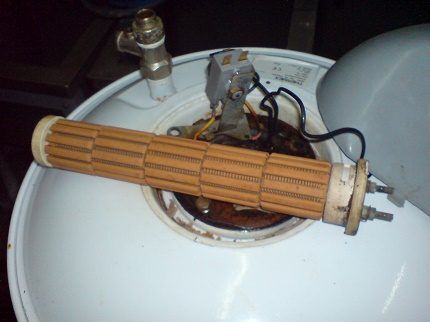
Due to the nature of operation, “dry” heating elements They burn out more often and need to be replaced, so models with “wet” heating elements more popular. It is worth noting that you can also find modern boilers with very reliable “dry” heating elements latest generation, but the cost of such devices may be too high.
But the amount of scale formed during operation, type heating element does not affect. But if with a “wet” element scale deposits directly on the surface, then with a “dry” heating element the deposits accumulate on the protective flask.
Vulnerable elements of a water heater
Even before installing the device, you should carefully study its technical data sheet and operating instructions. These documents usually quite accurately reflect the structure of the device, describe the position of the main elements, give recommendations for proper use, etc.
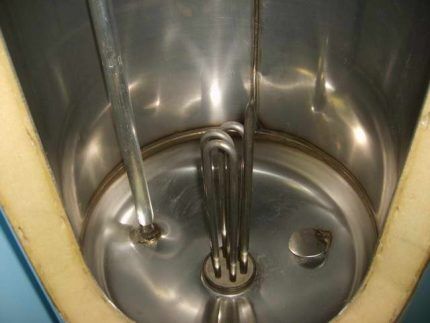
Many breakdowns of water heaters are in one way or another related to the tank, and they manifest themselves in the form of a leak. In order to respond correctly and choose the right strategy for eliminating problems, you must determine the location of the leak and identify its cause.
The cause of a leak is not always damage to the tank; more often its presence indicates that:
- the protective gasket is leaking;
- there were problems in the operation of the heating element;
- The thermostat and/or has deteriorated temperature sensor.
To protect the storage water heater, it is included in the piping circuit or built into the housing safety valve, the presence of which significantly reduces the number of breakdowns and emergency situations.
Sometimes a leak occurs in the area where the hot and cold water pipes enter the boiler body. Most often this is a consequence of improper installation, which appears immediately after putting the device into operation or shortly thereafter. You need to take care in advance to ensure that all connections are properly sealed.
In high-quality boilers, not one, but two or three thermostats are usually installed. The first regulates the water temperature level in the device, the second is needed to monitor the condition of the first, and the third device allows you to check the working condition of the heating element.
The design of these elements may vary. Rod and capillary devices are popular; the electronic version of the thermostat is considered very convenient to use. But the operating principle of such devices is almost the same; in the event of a breakdown, the device simply needs to be replaced with a similar model.
However, such a malfunction will not be critical to the operation of the boiler. If heating element OK, the device will still heat water.But lack of control over the heating temperature can lead to incorrect operation of the device. The result may be a broken heating element or other problems.
Cleaning and Maintenance
Following the manufacturer's recommendations can save the boiler owner from many problems. For example, the instructions usually recommend regular maintenance of the boiler, which boils down to an external inspection and cleaning procedure.
Typically, recommended maintenance periods vary depending on the type of heating element and the nature of its operation. For “wet” heating element It is recommended to carry out cleaning annually, and for “dry” - at least once every two years.
If the device is used under increased loads, for example, in production or in a public place, then maintenance should be carried out every six months, regardless of the type heating element.

The maintenance procedure may affect warranty service. Sometimes the manufacturer indicates in the documents that the procedure should be carried out not by the owner of the device, but by repairmen certified by the manufacturer. In this case, it is better to follow the manufacturer's instructions.
Carrying out maintenance yourself is not too difficult. To do this, you need to disconnect the boiler from the power supply and water supply, and then drain the water inside. After this, the housing is opened by unscrewing the mounting bolts and removed heating element. The heater and the inner surface of the tank are cleaned of scale and dirt.
The protective gasket and magnesium anode are replaced.Then the device is reassembled and connected to the electrical and water supply networks. One of the common causes of damage to the boiler tank is so-called electrical corrosion. It gradually destroys the surface of the drive, which leads to leakage.
To prevent this problem, many manufacturers install next to heating element magnesium anode. This element does not last forever; the task of the device owner is to promptly replace it with a new element. Unfortunately, some people forget about this, which can result in their boiler being completely damaged.
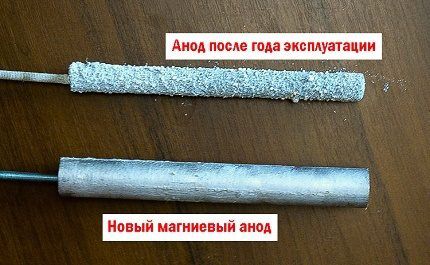
Do not forget about such an important protective element as grounding. Its absence not only creates a risk of injury when operating the device, but can also intensify or provoke electrocorrosion.
Troubleshooting common problems
The surface of the tank consists of several layers: the tank itself, insulation, outer casing, etc. This allows you to retain heat and save energy, but makes it difficult to repair the device.
The fact is that if the integrity of the internal tank or outer shell is damaged, then this has a devastating effect on the condition of the heat-insulating material.

The cause of tank failure may be careless handling of the device during installation and/or operation.If you drop a heavy object on the case or accidentally hit it, a chip, crack, or other similar damage may form on the surface.
It is almost impossible to fix such a breakdown on your own; you will have to either contact a service center or simply buy and install a new boiler. Of course, you can solder the hole inside or outside, but this method will only solve the problem for a while.
It is unlikely that it will be possible to provide sufficient protection for thermal insulation material at home. It will gradually deteriorate, as a result the boiler will retain heat much worse, and corrosion processes will develop. If the boiler begins to leak, this does not necessarily mean that the tank itself has deteriorated.
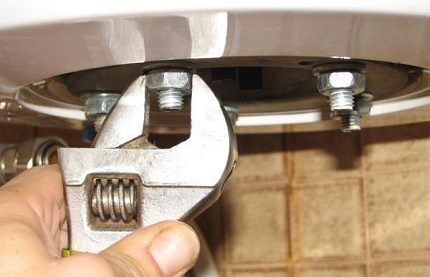
First you need to accurately determine the location of the leak. If water is leaking where the gasket is installed, you may just need to replace the element. The procedure for maintaining the device during which such an operation is performed has already been described above.
One of the most obvious and common boiler breakdowns is a malfunction heating element. If the water inside stops heating, this is most likely the problem.

Of course, before you begin dismantling and disassembling the device to replace the heating element, you should make sure that there is power in the house and that electricity flows freely to the boiler.For such a check, you should use a tester, applying it to the contact points.
To check, it is recommended to perform the following operations:
- The tester's measurement scale should be set to between 220 and 250 V.
- Record the voltage value at the terminals of the device connected to the electrical network.
- If there is no voltage, you can confidently state that the heater is faulty.
- If voltage is present, the test must be continued.
- The water heater should be disconnected from the power supply.
- After this, unfasten the thermostat from heating element and remove the insulation from the contacts of the heating element.
- Now you need to use a tester to measure the voltage on the non-insulated contacts.
- Lack of response allows us to conclude that there is a malfunction heating element, its presence indicates that the device is working properly.
heating element works fine, but the water doesn't heat up? The thermostat is probably faulty. To check this version, you should set the tester to maximum, and then check the voltage sizes at the input and output of the device.
Lack of response will indicate that a replacement needs to be made. The presence of voltage does not give a clear signal that the thermostat is working properly; the test should be continued.
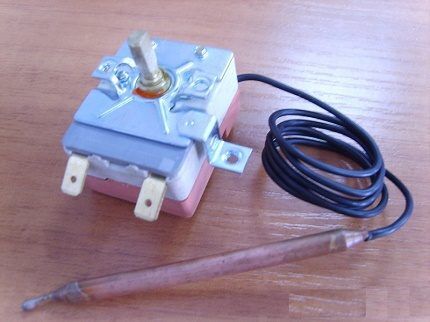
Now you need to set the tester to the minimum value and take measurements on the thermostat contacts for some time. If you cannot fix the sensors, you need to ask someone for help.
The edge should be heated temperature sensor (for example, using a lighter), and monitor the work thermostat. If heating caused it to open, the device can be considered serviceable. Lack of response indicates that a replacement needs to be made.
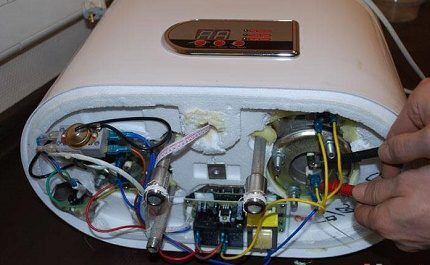
If heating element, and the thermostat are working normally, perhaps there is no heating due to incorrect settings of the device. A simple adjustment will solve the problem. Another possible scenario in this situation is a breakdown of the control board. In this case, you will have to seek help from a specialized center.
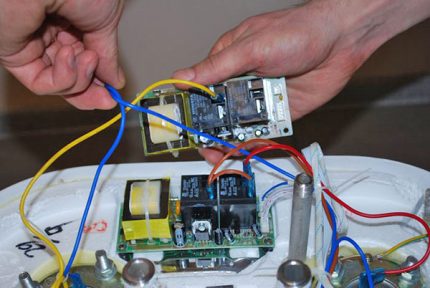
Replacement heating element, gaskets or any other element of the boiler must be carried out on a new part, which in all respects corresponds to the faulty one. Therefore, it is better to dismantle the old element and take it with you to the store.
It doesn’t hurt to study the product labeling or its characteristics set out in the boiler’s technical data sheet, so that a working element matches the broken one not only in appearance.
Boiler disassembly for repairs performed in the following order:
- Power and water supply are turned off.
- Drain the water inside.
- Unscrew the fasteners from the protective cover.
- Remove the cover.
- Dismantled heating element.
- Take out the thermostat and temperature sensor.
Wall-mounted models are usually easier to work with if you first remove them from the wall. The cover can be located on the bottom, side, or even on the front panel - it all depends on the model. Particular care must be taken when handling temperature sensor.
If the device's bulbs accidentally break, they cannot be repaired. Most likely, you will have to completely replace the entire thermostat.
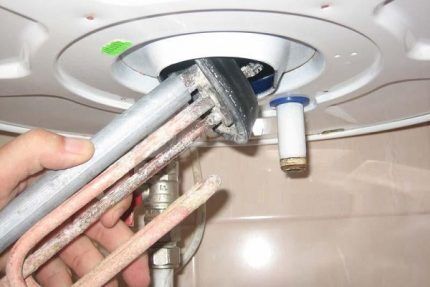
It also helps to be careful when removing the heating element. If on the surface heating element or the flask that protects it has accumulated too much scale, it may be difficult to remove it from the tank. Sudden movements and excessive force can cause permanent damage.
If you encounter a problem that you cannot solve on your own, be sure to contact the service center. Only a specialist can make an accurate diagnosis, correctly perform repairs or install a new part.
We bring to your attention the article - Why does the boiler shock?.
Conclusions and useful video on the topic
The experience of professionals and amateurs is the best advisor when carrying out DIY repairs. Perhaps useful videos will help you identify the problem and fix it.
An option for eliminating a boiler leak using cold welding is presented in this video:

The procedure for cleaning the boiler is clearly presented here:

This video clearly demonstrates the procedure for checking the electrical elements of a boiler using a tester:

Self-repair of a boiler comes down mainly to replacing damaged elements. Timely maintenance, correct installation and compliance with operating rules will prevent many breakdowns and extend the life of the device.
Please write comments, post photos, and ask questions in the block below.Tell us about how you restored the water heater to work with your own hands. It is possible that your recommendations will be very useful to site visitors.




I would like to ask, if the safety valve begins to leak, what do they do in such cases, where to start the repair? I also wanted to clarify the following situation: when we turn on the water in the tap, sometimes it feels like there is a slight electric shock, could this mean that there is some kind of breakdown in the boiler? Or is it not related to the boiler? We also have suspicions that the heating element in the washing machine may have become covered.
Hello. Unfortunately, this can mean anything and there is no point in experimenting here if you don’t know the exact source. Do not open the water supply taps when the boiler or washing machine is plugged in until the system has been thoroughly tested by an electrician. Mild may turn into serious electric shock. You can rummage around in the washing machine as much as you want, it might be a problem with the boiler, but the reason could be in the wiring or something else. Until the bell rings, one can only guess on the tea leaves, but we do not accept such methods.
Now about the valve. What can cause it to leak:
1. Poor quality safety valve (solution - replace).
2. A blockage that prevents the check valve from sealing tightly (clean, but easier to replace).
3. Increased pressure in the water supply system (here it is best to install a pressure reducer, since if the valve breaks, such a trick could even cause the water-heating flask to rupture).
On average, per day, a 100-liter boiler can release from 3 liters of water into the drainage system. The maximum value is 5 liters, but it is better to look in the device passport.
Again, it is impossible to diagnose the condition of the boiler by letter. You would take a photo of your system, tell us in what state it is leaking - when the water supply is on or off, when working on the network or at rest, and so on. And in what place, in what quantities. What kind of water supply system do you have, etc. Then we would be able to answer you what happened there and how to “cure” it.
Is the valve leaking? You may be confusing it with an excess fluid discharge device, a safety valve. In this case, the broiler functions normally. It’s hard to say right away about the current. If we take into account the washing machine, then I would advise checking the grounding. The main thing is not to turn a blind eye to this. Water and electricity are not toys, you understand.
If the boiler gives an electric shock and does this on a constant basis, then it is likely that there is a breakdown through the heating element. I would smoke in the direction of this - I would check the heating element for breakdown, and I would not be stingy and take a cord with an ouzo ampere of 16 - 20. So at least it won’t kill you with an electric shock if something happens.
Hello. Your remark is interesting. The safety valve has a starting spring mechanism in the inner part of the groove, which performs the functions of a check valve, and a spring mechanism on the outlet part, which is a device for releasing water when the pressure rises. These are not different devices. That is, formally, to say that the valve is leaking is true, even if it comes from the water discharge valve.
We recently installed a boiler at home - first the heating element burned out and the cold water valve broke. The valve has been replaced. And in the morning there was noise in the pipes and hot water everywhere (in the pipes).They turned off the water, turned off the electricity - the hose to the washing machine burst and hot steam came out of it. What is the reason for the breakdown?
Hello. There are connection problems here. Please take a photo of the connection diagram for your boiler.
After a year, my magnesium anode looks nothing. I mean, there is practically none at all. Apparently the quality of the water is so bad that he simply dissolves in it. Therefore, I change it more often - once every six months. In a good way, I need to install a filter at the entrance, but I still can’t give birth. Either there is no money, or there is no time.
Hello! I have a flat Ariston VLS 50L, after service to replace the anodes, when it was turned on, it began to show the error “No hot water when the heating element is on - water heater inlet tank.” Tell me, what could these masters break?
Hello! This problem is that there are extraneous sounds in the boiler, as if gurgling periodically and the water is running either hot or cold. And for some reason, with different pressures, sometimes stronger, sometimes weaker. Tell me what to pay attention to and how to get rid of this problem. Thank you.
Good afternoon. This is the problem: when we turn on the water heater at full power, the indicator lights up for a while and then goes off. Turn on the tap, it runs hot for 5 seconds, then immediately cold. The water heater itself is warm, that is, the water in it is warm and the water running is cold. What is the reason?
Hello. There are a number of reasons why a water heater does not heat water: low water pressure, a malfunction of the boiler itself, a malfunction of the thermostat, a broken heating element.
Hello.The pipe supplying cold water to the boiler is heating up, the toilet tank is connected to it, and for some reason hot water flows into the tank (from the pipe where the cold water is). With what it can be connected?
Hello. The leak formed from under the temperature gauge (Atlantic). What could be wrong and how can I fix it?
Good afternoon. You should contact a refrigerator repair specialist.